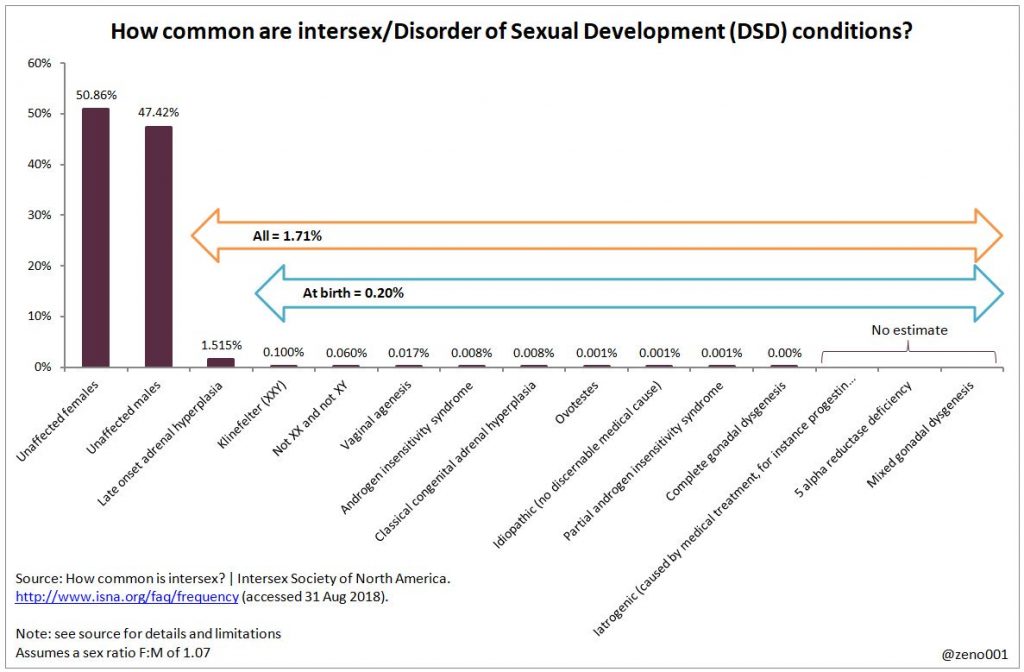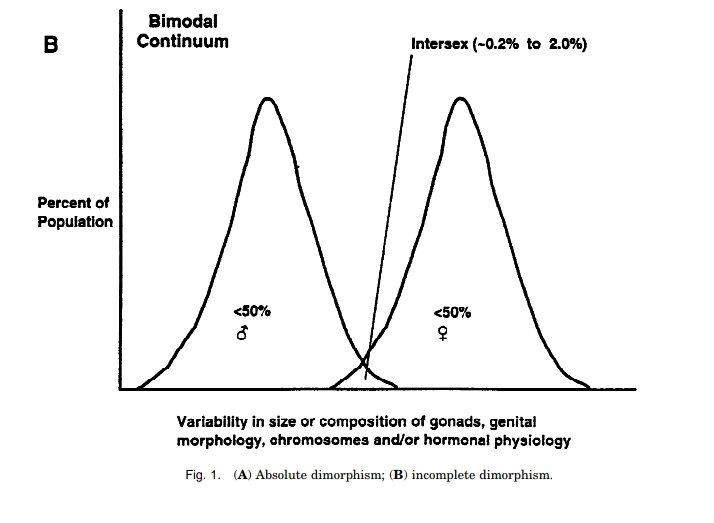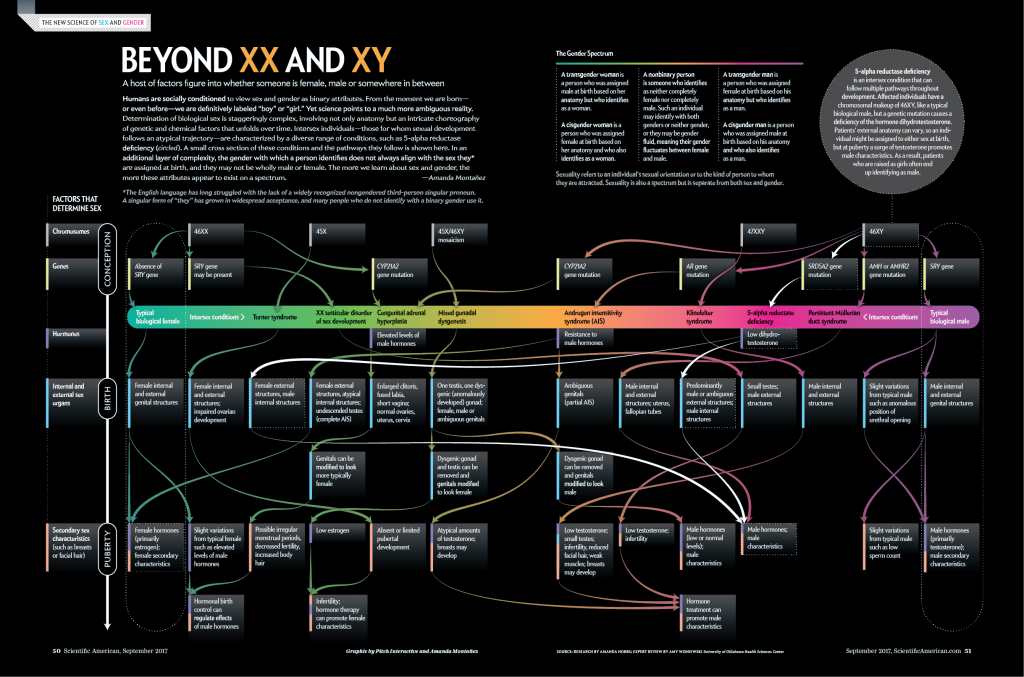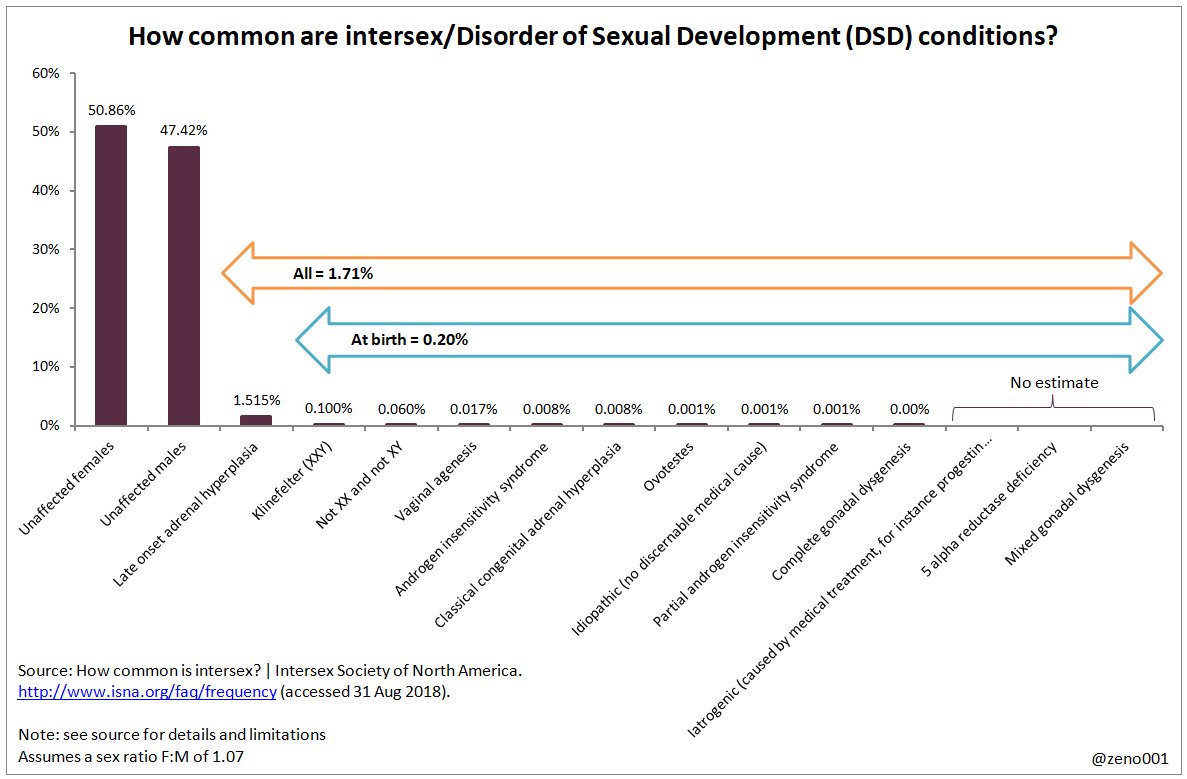Today we’re going to talk statistics and semantics. I’m going to do so via the medium of one of social media’s favourite stats 1.7% (aka “intersex is as common as red heads.”). The statistic comes from Fausto-Sterling’s work, which you can see a review of here.
To understand the statistic, we have to drill down into what the meaning of the word “intersex” is. Most people think of hermaphrodites. Let’s stress at the beginning, there has been no example ever of a human being with both sets of working reproductive organs. There is a very tiny percentage of people who are born with both testicular and ovarian tissue (what Fausto-Sterling calls “true hermaphrodites”). And when I say tiny, we’re talking intersex tiny, as in 0.0117/1,000 livebirths, or one in 100,000. These are very complex cases, but still not actual hermaphrodites.
So, how do we arrive at 1.7%? What Fausto-Sterling does is apply a wider scope. Instead, she argues that intersex is anything that doesn’t fit into a platonic ideal. The platonic ideal, in this case, being a phenotypically perfect XX female and a phenotypically perfect XY male. This means that intersex, used in the context of the 1.7% statistic, includes people for whom there is no sexual ambiguity.
Take, for example, Klinefelter syndrome (XXY males). As Fausto-Sterling acknowledges, many males can go their whole life and not realise they are XXY. In fact, the section on chromosomal conditions (anything outside of XX or XY) specifically sets out how they can be categorised, into male or female, according to gonadal (sperm/egg production) sex and phenotype (other primary and secondary sex characteristics e.g. genitals).
Other cases that are easily categorised into male or female include conditions like mine (MRKH), and males with penile agenesis. We have XX or XY chromosomes but absent or incomplete penis or vagina. In males this only occurs in around 1/1,000,000 births but it is more common in women. Nonetheless, we are still genotypically, chromosomally, phenotypically and usually gonadally typical males or females.
See how robust this sexual dimorphism is? Nature is amazing.
Fausto-Sterling also includes variations such as CAH. This is more complex. Classic CAH can lead to ambiguous genitalia. This probably isn’t what people think it is though. In the case of CAH it would be virilised female genitalia. Males with CAH will not have ambiguous genitalia. Typically, virilised female genitalia means an enlarged clitoris and sometimes a fused labia. These might appear “masculine” but they are female. An enlarged clitoris is not a penis. I’ve written more about this before.
However, Fausto-Sterling also includes any ambiguity caused during someone’s entire lifetime, known as late onset, which extends the definition beyond congenital cases not of “the platonic ideal” to cases where no difference or ambiguity would be present at birth at all. This is important as late onset adrenal hyperplasia, people who are unambiguously genotypically, phenotypically and gonadally either male or female at birth, account for 1.5% of that 1.7% statistic.

So far, what we have seen is that, apart from those rare 1/100,000 cases, “intersex” now includes a lot of people who are actually still unambiguously male or female. I know this is really boring and nowhere near as exciting as “intersex people are clown fish actually”, sorry.
This is quite long, and I’m going to wrap it up soon but there is one condition that needs discussing, as it’s probably one of the most frequently cited…AIS.
AIS (Androgen Insensitivity Syndrome) is complicated as there are different forms. A quick overview; it affects genetic males, as in XY individuals. The individuals are unable, to varying degrees, to process androgens. In other words, they cannot respond to testosterone in the way other XY males can. Phenotypical features range from a fully female external phenotype, with a blind-ending vagina and little axillary hair development, to someone with infertile male syndrome. AIS is one of the rare occasions where sex may be assigned rather than observed. As women with CAIS have bodies that are unable to respond to the hormones that produce a male appearance, they are observed and recorded as female at birth and raised as girls, their condition does not usually becoming evident until puberty when their periods do not start.
I always find it ironic when people rollout “some CAIS women have given birth” as a gotcha. Yes, they have, with the help of extensive fertility treatments and other medical interventions, and it kinda underlines why using female makes sense here and isn’t an imposition or a mistake, nor proof that other XY individuals need the same inclusion. I recommend following @ClareCAIS, on Twitter, to learn more about CAIS.
The thing that annoys me most about Fausto-Sterling, and the copycats who followed, is their need to make it all visually tidy. Sterling does it with this graph, which represents precisely nothing that’s said.

You’ll see similar being used in lots of the “sex spectrum” arguments, such as this one which is often shared online by trans activists.

In what way are many of these conditions a coexistence of male and female or “somewhere in between”? It’s conceptually pretty but scientifically drivel.
I want to make one thing clear here, I’m not against the 1.7% being acknowledged as a group. It’s sensible for us to work together. Just not this. What I am trying to point out is that there is an incongruence between the statistics used for intersex conditions and what people think intersex means. The vast majority of the 1.7% are unambiguously male or female. These conditions prove how robust dimorphism is. To get an idea of what I mean, read this all again, then try explaining it to someone else without using the words male or female. Biology, and sex, matters.
Addendum: Since I first wrote this thread on Twitter, the BBC have done their own excellent fact check of the 1.7% statistic, you can catch their podcast about it here.

